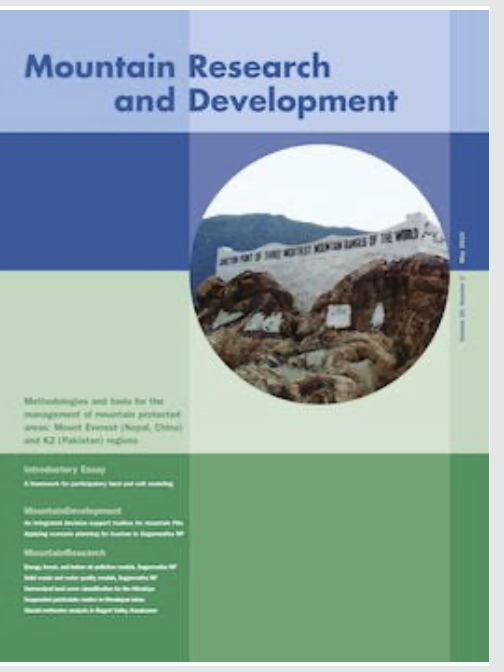Contact for the resource
International Mountain Society
4 record(s)
Type of resources
Available actions
Topics
Keywords
Contact for the resource
Provided by
Update frequencies
Status
-

Special Issue: Methodologies and Tools for the Management of Mountain Protected Areas: Mount Everest (Nepal, China) and K2 (Pakistan) Regions.
-

High mountains have sensitive social-ecological systems (SESs) characterized by fragility, complexity, and marginality. The local economies of these environments mainly rely on primary production, tourism, and leisure activities; thus human–ecosystem interactions are intricately linked. Many authors stress that this strict relationship must be assisted with a participatory approach involving interested stakeholders in the conceptualization, specification, and synthesis of knowledge and experience into useable information for the express purpose of addressing a problem complex. This paper presents experience garnered with a participatory modeling framework combining hard and soft methodology in 2 case studies: the Sagarmatha National Park and Buffer Zone (Nepal) and the Central Karakoram National Park (Pakistan). The modeling framework was developed based on local stakeholders' demands and needs; it consists of 5 modules, briefly presented here along with their conceptual background. In developing the framework, particular emphasis was given to considering the needs of decision-makers at the local level, rather than simply providing technical solutions to abstract problems. From the development of this modeling process, a need emerged to structure a management-oriented research module in order to generate management knowledge that is both stakeholder-relevant and evidence-based. The application of the framework in the 2 cases studies showed that the modeling can trigger valuable discussion among stakeholders as well as guidance for management-oriented research and feedback loops ensuring validation of knowledge. In addition, the resulting scenarios can help decision-makers in defining pathways for sustainable development in mountain areas, where people's livelihoods are closely dependent on ecosystems. The framework was developed in such a way that it can be replicated in other mountain areas with similar challenges.
-

High mountains have sensitive social-ecological systems (SESs) characterized by fragility, complexity, and marginality. The local economies of these environments mainly rely on primary production, tourism, and leisure activities; thus human–ecosystem interactions are intricately linked. Many authors stress that this strict relationship must be assisted with a participatory approach involving interested stakeholders in the conceptualization, specification, and synthesis of knowledge and experience into useable information for the express purpose of addressing a problem complex. This paper presents experience garnered with a participatory modeling framework combining hard and soft methodology in 2 case studies: the Sagarmatha National Park and Buffer Zone (Nepal) and the Central Karakoram National Park (Pakistan). The modeling framework was developed based on local stakeholders' demands and needs; it consists of 5 modules, briefly presented here along with their conceptual background. In developing the framework, particular emphasis was given to considering the needs of decision-makers at the local level, rather than simply providing technical solutions to abstract problems. From the development of this modeling process, a need emerged to structure a management-oriented research module in order to generate management knowledge that is both stakeholder-relevant and evidence-based. The application of the framework in the 2 cases studies showed that the modeling can trigger valuable discussion among stakeholders as well as guidance for management-oriented research and feedback loops ensuring validation of knowledge. In addition, the resulting scenarios can help decision-makers in defining pathways for sustainable development in mountain areas, where people's livelihoods are closely dependent on ecosystems. The framework was developed in such a way that it can be replicated in other mountain areas with similar challenges.
-

This paper presents the results of management-oriented research on energy, forest, and human health issues in a remote mountain area, the Sagarmatha National Park and Buffer Zone (SNPBZ), Nepal. The research was based on a broader, integrated participatory framework ultimately intended for use in adaptive management. The present study focused on the application of a participatory modeling framework to address problems related to energy demand and consumption, forest condition, and indoor air pollution, which were defined by the stakeholders as important issues to be addressed. The models were developed using a generalizing design that allows for user-friendly adaptation to other contexts (free download at http://hkkhpartnership.org). Moreover, we simulated management scenarios in collaboration with all modeling actors with the aim of building consensus on the understanding of the system as well as supporting decision-makers' capacity not only to respond to changes, but also to anticipate them. Importantly, the system dynamics assessment found that the SNPBZ forests are affected by an increasing demand for fuelwood (occurring due to tourism growth), as one of the main sources of energy. Selected forests show an average reduction of 38% in forest biomass from 1992 to 2008. This shows that the business-as-usual scenario is unlikely to result in the preservation of the current forest status; in fact, such preservation would require 75% of fuelwood to be replaced with alternative energy sources. At the same time, a 75% reduction of fuelwood use (and an 80% reduction of dung use) would reduce indoor carbon monoxide (CO) concentrations to the standard limits for CO exposure set by the World Health Organization.
